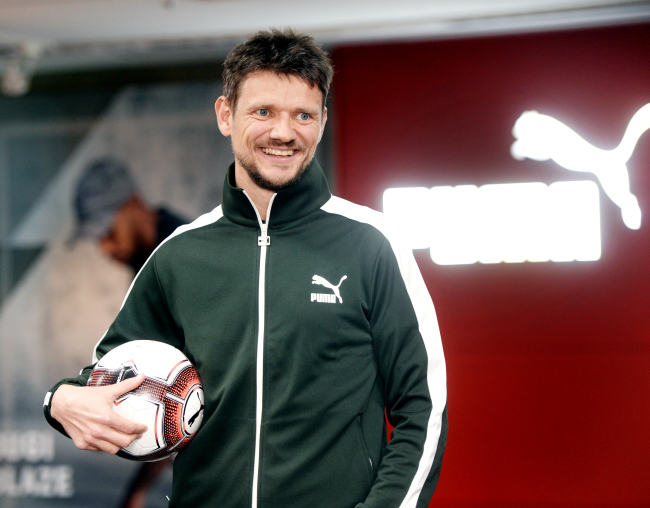The future of athletic wear in Korea hinges on the female consumer, according to the general manager of Puma Korea.
“The female consumers are spending more money than the men. They’re very trend savvy, and I think that the current athleisure trend is one that has performance and fashion meeting each other,” said Rasmus Holm, Puma Korea’s GM, in an interview with The Korea Herald.
 |
Puma Korea CEO Rasmus Holm at Puma’s showroom in Dongjak-gu, Seoul (Park Hyun-koo/The Korea Herald) |
According to Danish-born Holm, who has been working in the athletic wear market with Adidas and Puma for 15 years, with 10 of them in Asia, spending by female consumers in Korea makes up more than about 55 percent of total sales for Puma.
That number is likely to grow as the athletic wear market here becomes more fashion-conscious, with increasing influence from sectors like fashion and entertainment.
“Especially in Korea, fashion and music and dramas play a massive role not only for us,” he said. “It wasn’t that way 10 years ago.”
Puma has been one of the most aggressive brands in chasing ways to combine its athletic heritage with the latest trends, working with spokesmodels like pop star Rihanna and K-pop stars BTS, Hyeri and Nana here to create a younger image.
“The key target consumer is the fashion-savvy, cool kid that sets the trend for the sports market,” Holm said, pointing to consumers in the 16-24 age group. “They’re very connected, and they influence a lot of people. They’re difficult to reach. They jump around a lot. But they are the ones who will be setting the trends for the future in this space.”
Holm says that he sees the growing influence of fashion in the sportswear market as an opportunity rather than a challenge to performance-based athletic wear’s authenticity.
“I think it‘s important to say that Puma is a sports brand first. That’s our heritage, that’s who we are, that’s what we do,” he said. “But sport is trendy. I don’t think the trend takes away from sportswear. I think it can actually enhance both sports culture and street culture.”
The opportunity is especially pronounced for Puma because of its past image of being more fashionable and colorful than other sports brands.
“Puma is a very cool cat. It’s important that we are perceived as being cool, because it allows us to be a little more rebellious and more aggressive in many ways,” Holm said, noting that Puma’s products for football were often more colorful and uniquely designed than those of other brands.
“I think that’s sort of the niche within the football category where we can find space to compete.”
Finding these types of niches is critical in Korea because consumers here are highly aware of their alternatives, according to Holm.
“If you look at the expansion of stores and brands, it’s fair to say that the Korean athletic wear market is always growing. It doesn’t mean that it’s an easy market to enter. It’s a very expensive market, very competitive. You have more sports brands in Korea than anywhere else in the world, and there are many local players here that are doing really good jobs.”
This is partly why Puma in the short term will look to maximize profits from its existing stores and play to its strengths of football and women’s training categories, Holm said.
“We will expand our stores for sure, but again what’s important is that we maximize the ones we have. It’s a matter of improving our operational standards, that we are better at delivering. Once you do that in a sustainable manner, you are ready to roll out stores,” he said. “Expansion for the sake of expansion is not really worth it unless you know it’s sustainable.”
“My focus will be on getting our team, as a whole to really understand our consumers and create a consumer-oriented approach.”
By Won Ho-jung (
hjwon@heraldcorp.com)








